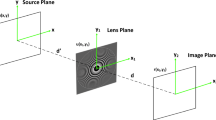Abstract
With the analysis of the features of image edge based on the defocused model of optical imaging system, a blur estimation and detection method for out-of-focus images is proposed. The essential idea is to estimate the parameter of the point spread function, which reflects the blurriness of image. Based on the notion, the proposed method estimates the parameter values by different straight edges in the image, and the parameter distribution is used to measure the image blurriness. Then it can determine whether an image is blurred or not by comparing with a predetermined threshold. Experiment results show that the proposed blur metric is highly correlated to subjective visual perception, and it can be implemented to estimate and detect the blurriness for out-of-focus images with different scenes.












Similar content being viewed by others
References
Anish M, Anush Krishna M, Alan Conrad B (2012) No-reference image quality assessment in the spatial domain. IEEE Trans Image Process 21(12):4695–4708
Aslantas V (2007) A depth estimation algorithm with a single image. Opt Express 15(8):5024–5029
Bong D, Khoo B (2014) Objective blur assessment based on contraction errors of local contrast maps. Multimed Tools Appl 1–24
Canny J (1986) A computational approach to edge detection. IEEE Trans Pattern Anal Mach Intell 8(6):679–698
Caviedes JE, Gurbuz S (2002) No-reference sharpness metric based on local edge kurtosis. Int Conf Image Process 3:53–56
Caviedes JE, Oberti F (2004) A new sharpness metric based on local kurtosis, edge and energy information. Signal Process Image Commun 19(2):147–161
Ferzli R, Karam LJ (2009) A no-reference objective image sharpness metric based on the notion of just noticeable blur (JNB). IEEE Trans Image Process 18(4):717–728
Final report from the Video Quality Experts Group on the validation of objective models of video quality assessment, VQEG, 2000
Gonzalez RC, Woods RE, Masters BR (2009) Digital image processing, Third Edition. J Biomed Opt 14 (2)
Hassen R, Wang Z, Salama M (2010) No-reference image sharpness assessment based on local phase coherence measurement. Int Conf Acoust Speech Signal Process 2434–2437
Joshi N, Szeliski R, Kriegman DJ (2008) PSF estimation using sharp edge prediction. Comput Vis Pattern Recognit 1–8
Larson EC, Chandler DM (2010) Most apparent distortion: full-reference image quality assessment and the role of strategy. J Electron Imaging 19(1):1–21
Liang L, Chen J, Ma S, Zhao D, Gao W (2009) A no-reference perceptual blur metric using histogram of gradient profile sharpness. IEEE Int Conf Image Process 4369–4372
Libin S, Sunghyun C, Jue W, Hays J (2013) In Edge-based blur kernel estimation using patch priors. 2013 I.E. International Conference on Computational Photography (ICCP), 2013 1–8
Liu X, Sun C, Yang L (2015) DCT-based objective quality assessment metric of 2D/3D image. Multimed Tools Appl 74(8):2803–2820
Liu H, Wang J, Redi J, Callet PL, Heynderickx I, (2011) An efficient no-reference metric for perceived blur. Eur Workshop Vis Inf Process
Marichal X, Ma W-Y, Zhang H (1999) Blur determination in the compressed domain using DTC information. Int Conf Image Process 386–390
Marziliano P, Dufaux F, Winkler S, Ebrahimi T (2002) A no-reference perceptual blur metric. Int Conf Image Process 3:57–60
Marziliano P, Dufaux F, Winkler S, Ebrahimi T (2004) Perceptual blur and ringing metrics: application to JPEG2000. Signal Process Image Commun 19(2):163–172
Narvekar ND, Karam LJ (2011) A no-reference image blur metric based on the cumulative probability of blur detection (CPBD). IEEE Trans Image Process 20:2678–2683
Ong E, Lin W, Lu ZY, Yang X, Yao S, Pan F, Jiang L, Moschetti F (2003) A no-reference quality metric for measuring image blur. Int Symp Signal Process Appl
Pentland A (1985) A new sense for depth of field. Int Joint Conf Artif Intell 988–994
Ponomarenko N, Lukin V, Zelensky A, Egiazarian K, Carli M, Battisti F (2009) TID2008-A database for evaluation of full-reference visual quality assessment metrics. Adv Mod Radioelectron 10(10):30–45
Sheikh HR, Wang Z, Cormack L, Bovik AC. LIVE2 image quality assessment database release 2, http://live.ece.utexas.edu/research/quality
Subbarao M, Gurumoorthy N (1988) Depth recovery from blurred edges. Comput Vis Pattern Recognit 498–503
Sun Y, Duthaler S, Nelson BJ (2004) Autofocusing in computer microscopy: selecting the optimal focus algorithm. Microsc Res Tech 65(3):139–149
Tong H, Li M, Zhang H, Zhang C (2004) Blur detection for digital images using wavelet transform. Int Conf Multimedia Comput Syst/Int Conf Multimedia Expo 17–20
Wang Z, Bovik AC (2009) Mean squared error: love it or leave it? a new look at Signal Fidelity Measures. IEEE Signal Process Mag 26(1):98–117
Wang Z, Bovik AC, Sheikh HR, Simoncelli EP (2004) Image quality assessment: from error visibility to structural similarity. IEEE Trans Image Process 13(4):600–612
Wang Z, Li Q (2011) Information content weighting for perceptual image quality assessment. IEEE Trans Image Process 20(5):1185–1198
Wang Z, Simoncelli EP, Bovik AC (2003) Multiscale structural similarity for image quality assessment. Asilomar Conf Signals Syst Comput
Zhu X, Cohen S, Schiller S, Milanfar P (2013) Estimating spatially varying defocus blur from a single image. IEEE Trans Image Process 22(12):4879–4891
Acknowledgments
The authors would like to thank the accompaniers working with me in department of aerial, detective Laboratory of the optics and Electronics, Institute of Optics and Electronics, Chinese Academy of Sciences. Many thanks also to Karam, L. J. et al. for providing the software of JNBM [7] and CPBDM [20]. We also thank the anonymous reviewers whose comments led to substantial improvements in this manuscript.
Author information
Authors and Affiliations
Corresponding author
Rights and permissions
About this article
Cite this article
Hong, Y., Ren, G., Liu, E. et al. A blur estimation and detection method for out-of-focus images. Multimed Tools Appl 75, 10807–10822 (2016). https://doi.org/10.1007/s11042-015-2792-1
Received:
Revised:
Accepted:
Published:
Issue Date:
DOI: https://doi.org/10.1007/s11042-015-2792-1




